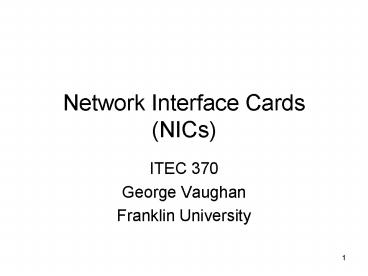Network Interface Cards NICs - PowerPoint PPT Presentation
Title:
Network Interface Cards NICs
Description:
Material in these s comes primarily from course text, Guide to ... Last 3 numbers = Unique Address for the card (Turquoise) MAC Address is burned on card ... – PowerPoint PPT presentation
Number of Views:232
Avg rating:3.0/5.0
Title: Network Interface Cards NICs
1
Network Interface Cards (NICs)
- ITEC 370
- George Vaughan
- Franklin University
2
Sources for Slides
- Material in these slides comes primarily from
course text, Guide to Networking
Essentials,Tomsho, Tittel, Johnson (2007). - Other sources are cited in line and listed in
reference section.
3
TCP/IP and OSI Models
4
NIC
- NIC Network Interface Card
- Hardware that connects computer to Network Media
- NIC plugs into computer backplane (bus).
- NIC is gate keeper for computer.
- Uploading data
- NIC reads data (bits) from the system bus
(parallel) - NIC packages data into frames along with error
check codes and address. - NIC ships frames out onto the network medium
(serial) - Downloading data
- NIC reads frames from network medium and checks
address (serial) - NIC unpacks data and performs error checking
- NIC places data (in bits) onto the system bus
(parallel)
5
From Parallel to Serial and Vice Versa Tomsho,
Tittel, Johnson (2007).
Bus width
6
NIC and Backplane (Bus)
- NIC plugs into computer backplane (bus).
- The backplane (bus) on a computer
- Is a connection between CPU, memory, and certain
devices such as the NIC. - Typically supports 32 bit or 64 bit parallel
communication (for high speed) - Bus types described later.
- NIC must match the number of bits in backplane
(bus width). - Many computers have incorporated the
functionality of NIC on motherboard.
7
Bus Types
8
NIC and Network Media
- NIC also has an interface to the network.
- Interface may be a wired or wireless serial
connection. - Wire interface may support coax, twisted-pair or
fiber or some combination of the three. - Wireless interface consists of a transceiver and
antenna (which may be internal to card).
9
NIC With Multiple Interfaces Tomsho, Tittel,
Johnson (2007)
10
Wireless Adapters Tomsho, Tittel, Johnson (2007)
11
NIC Buffer
- NIC also contains a buffer (memory)
- Buffer is used to manage traffic bursts either
from the CPU or from network. - Buffers allow CPU and network to operate more
efficiently. - The bigger the buffer, the better the performance
of both CPU and network. - A slow NIC can affect others on network.
12
NIC Address and OSI Model
- NIC has link address burned in (MAC address)
- MAC Media Access Control 48 bits.
- MAC Example (Hex)
- 0020ED73B71D
- First 3 numbers Manufacturer (Red)
- Last 3 numbers Unique Address for the card
(Turquoise) - MAC Address is burned on card
- NIC manages layer 2 (link layer) for computer.
- NIC also provides interface to network media
(layer 1 or physical layer).
13
Available NIC Features
- Direct Memory Access (DMA) direct access to CPU
memory. - Shared Adapter Memory NIC buffer mapped into
CPU memory - Shared System Memory CPU memory mapped into NIC
buffer - Bus Mastering NIC can control Bus
- NIC Buffer Size
- On-board Co-processors NIC can process network
data w/o main CPU
14
Available NIC Features
- Security NIC on-board support for IPSec
- Traffic Management Quality of Service (QoS)
- Automatic Link Aggregation Multiple NICs to
multiply bandwidth - Fault tolerance Multiple NICs
- Wake-on-Lan Remote computer power-up by special
signal received by NIC.
15
Choosing Network Adapters for Best Performance
Tomsho, Tittel, Johnson (2007)
- Increased performance features have payoffs for
servers that might not apply to workstations - The following is a checklist for purchasing NICs
- Bus widthHigher is better
- Bus typeUse 64-bit PCI-X or PCIe for servers
- Memory transferShared memory outpaces I/O or DMA
- Special featuresChoose security, management,
protocol-handling, and hot-plug capabilities - Bus masteringImportant for servers
- Vendor factorsLook for quality, reliability,
staying power, and reputation
16
References
- Tomsho, Tittel, Johnson (2007). Guide to
Networking Essentials. Boston Thompson Course
Technology. - Odom, Knott (2006). Networking Basics CCNA 1
Companion Guide. Indianapolis Cisco Press - Wikipedia (n.d.). OSI Model. Retrieved 09/12/2006
from http//en.wikipedia.org/wiki/OSI_Model































